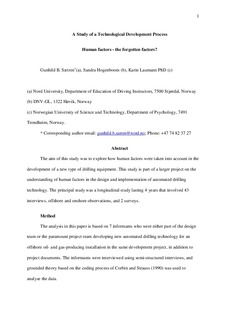A study of a technological development process : Human factors – the forgotten factors?
Original version
Sætren, G.B., Hogenboom, S. and Laumann, K. (2016). A study of a technological development process : Human factors – the forgotten factors? Cognition, Technology and Work, 18(3), 595-611. doi: 10.1007/s10111-016-0379-xAbstract
The aim of this study was to explore how human factors were taken into account in the development of a new type of drilling equipment. This study is part of a larger project on the understanding of human factors in the design and implementation of automated drilling technology. The principal study was a longitudinal study lasting 4 years that involved 43 interviews, offshore and onshore observations, and two surveys. The analysis in this paper is based on seven informants who were either part of the design team or the paramount project team developing new automated drilling technology for an offshore oil- and gas-producing installation in the same development project, in addition to project documents. The informants were interviewed using semi-structured interviews, and grounded theory based on the coding process of Strauss and Corbin (Basics of qualitative research: grounded theory procedures and techniques. Sage, Newbury Park, 1990) was used to analyse the data. The core category was found to be insufficient human factor analyses performed in the development phase due to the two main categories, namely (1) insufficient information coordination and (2) narrow focus in different phases of the project. This was found to contribute to increased costs, low user-friendliness, and end users’ insufficient knowledge of safe usage and potential risks. Our conclusion was that homogenous top competence involving technical aspects contributed to developers’ lack of understanding of the need for sufficient analyses of end user requirements and of the tasks that would be affected by the new technology. Hence, we argue that technological development could benefit from including human factors experts from the project’s outset to bridge the gap between the lack of relevant information and sufficient information on which to base development decisions. In addition, we contend that performing human factors analyses throughout the development of a project would be beneficial due to the potential of hindering cultural aspects such as a non-questioning culture, which is viewed as a hazard in high-risk organizations.
